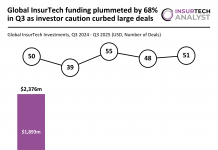Often seen as an industry lambasted for a lack of change, the insurance sector has opened its eyes to a swathe of potential innovative technologies that could revolutionise the sector throughout 2024. At the height of this movement, the principle of automated underwriting emerged as the industry’s great fascination, with many touting it as a potential silver bullet.
FinTech Global‘s Harry Slade sat down with Earnix‘s Director of Strategy, Aaron Wright, to mull over the potential of automated underwriting – and decide whether it can truly be a catalyst for change in the space.
Leveraging advanced technologies such as artificial intelligence, machine learning, and big data analytics, automated underwriting streamlines the traditionally cumbersome and manual process of risk assessment.
Proponents argue that this significant enhancement to an insurers day-to-day can have seriously positive knock-on effects, leading to cost savings for insurers, but also delivering a faster and more seamless experience for customers, potentially reshaping the competitive dynamics of the insurance industry.
As the landscape of risk changes for insurers due to the ever-evolving economic turbulence faced internationally, Wright admitted it was time for underwriters to begin transforming their methods.
“Risk is evolving due to multiple factors including economic, catastrophic and climate events as well as technology (smart cars and home). Underwriters need to evolve the way they work to harness the increasingly sophisticated analytics that are available and avoid taking on higher risk due to lack of agility in underwriting and limited rule sophistication,” explained Wright.
“AI enables the ability to adjust to new patterns more rapidly than the traditional regression-based approach. This means using data and analytics to drive decision making, and existing technology and processes don’t support the innovation and sophistication needed to be successful. More data and analytical sophistication are needed to make smarter decisions with more complex underwriting needs.”
By achieving this, insurers would be able to enable their underwriters to focus on more challenging tasks, and therefore avoid wasting their time focusing on the tedious and mundane challenges.
Wright explained how Earnix’s own offering is a microcosm of this shift. “By automating the underwriting process, insurers can enhance efficiency, reduce costs, and improve customer experience. This allows underwriters to focus on more complex risks that require their expertise and experience. Earnix’s Underwrite-It platform, for instance, embodies this paradigm shift, combining advanced analytics with traditional underwriting methods to deliver robust risk assessment frameworks,” he said.
Inside the key benefits
The potency of automated underwriting is incredibly clear to see. By leveraging the capabilities of AI and machine learning to dramatically enhance the efficiency and accuracy of the application process.
This advanced technology utilises extensive datasets from various sources, enabling AI algorithms to detect hidden patterns and trends. This leads to a more detailed and precise understanding of risk profiles, which is crucial for insurers.
A prime example of this technology in action is Earnix’s Underwrite-It. This platform allows insurers to rapidly adjust to market changes and evolving risk environments.
By incorporating self-learning algorithms and simulation techniques, Underwrite-It enables insurers to make informed, real-time decisions. This adaptability not only enhances operational efficiency but also provides a significant competitive edge in the fast-paced insurance sector.
The benefits of automated underwriting extend beyond simply processing applications more quickly. This technology optimises the entire underwriting process from start to finish.
Wright explained the importance of this, remarking, “Being dynamic is important not just to exploit insights rapidly since time to value is important, but also to accelerate through the whole underwriting process end-to-end and operationalise it. It is important for underwriters to be able to close the loop so that they can look back and see if the book of business is performing as expected, identify any drift and course correct if required.
“By leveraging advanced analytics and algorithms, insurers can optimise risk evaluation, adapt to market fluctuations, and enhance their competitive edge.”
Buoyed by this thought-process, insurers are now all turning to automated underwriting to solve their issues. A recent survey and report by Novarica revealed that 85% of life insurers have adopted paperless underwriting processes. Additionally, 77% of these insurers utilise automated data requests from third-party databases to meet underwriting requirements, and 77% partially depend on automated underwriting for decision-making.
What are the potential pitfalls?
Like with any game-changing, sector revolutionising idea, potential pitfalls and drawbacks are never too far away.
For the use of automated underwriting, the main cause for concern centers around biases during decision-making. Whilst this is not a new problem for industry incumbents, as it still remains with humans at the helm, it does certainly add an extra layer of concern.
Wright explained, “The risk of biases in decision-making exists whether the decisions are made by humans or algorithms, and are a concern for insurers and regulators alike. One advantage had by algorithmic decision-making is that the centralised point of decision can be tested addressed during development. It is critical to address these concerns proactively and with best practice in mind.”
But how can you combat these issues throughout the design process?
“Establishing ethical frameworks and guidelines that prioritise fairness, equity, and non-discrimination is critical to automated underwriting. These frameworks serve as foundational pillars, guiding the design and deployment of algorithms with ethical considerations at the forefront. Integrating mechanisms for bias detection and mitigation into automated underwriting systems is also key. By continuously monitoring data inputs and decision outputs, algorithms can identify and address potential biases effectively,” Wright declared.
On top of this, human oversight remains paramount. While automated systems offer efficiency and consistency, they are prone to replicating biases inherent in historical data or algorithmic design.
Human involvement is therefore crucial in identifying and rectifying these biases, ensuring that decisions are fair and equitable. It provides a necessary check to contextualise individual circumstances, uphold ethical standards, and maintain transparency and accountability in decision-making processes.
By integrating human judgment, underwriting systems can evolve responsibly, adapting to changing regulatory landscapes and societal expectations while prioritising fairness and minimising discriminatory practices.
So, silver bullet, or a band aid to wider issues? Automated underwriting may well reside as neither. While it is a clear enhancement to the entire value chain, insurers must remain cautious and vigilant to not let it run rampant with bias that will undermine the rest of your insurance model.
With his closing remarks, Wright added, “Automated underwriting is a powerful tool within the insurance industry, representing a pivotal shift towards efficiency and precision. While it’s not a silver bullet, it signals acceleration in the evolution of compliant, highly efficient and profitable insurance operations.”
Copyright © 2024 InsurTech Analyst










